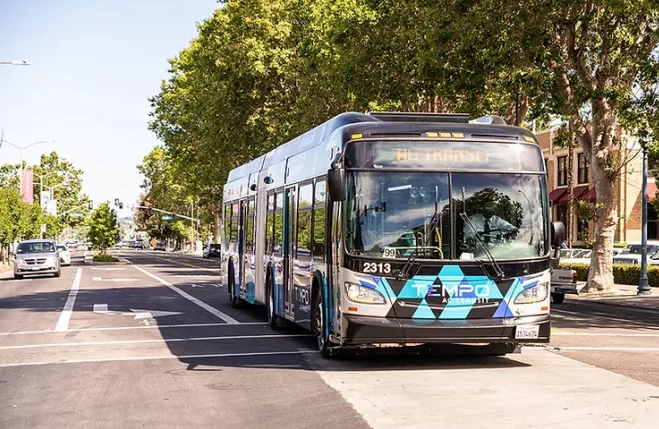The California legislature, recognizing that its recent funding bump for public transportation is not enough to address the many critical issues faced by transit agencies, called for the California State Transportation Agency (CalSTA) to convene a task force to find solutions. On December 19, 2023, the first Transit Transformation Task Force meeting was held in Sacramento. This post’s author, Laurel Paget-Seekins of Public Advocates, is one of 25 task force members who represent transit agencies, regional planning organizations, state transportation agencies, transit advocates, and business, academic, and labor organizations.
California needs to get more people to ride transit in order to meet its climate and other goals. But the state’s transit systems are not even serving the needs of their daily transit riders, let alone people stuck in cars wishing transit would work for them. Our state’s transit agencies do not have enough operating funding to provide the level of transit service necessary, a problem that was exacerbated by the pandemic. This is especially true for transit agencies that rely more heavily on fare revenues for operating funds. The recent transit funding included in California’s 2023 budget package provided only temporary funding, and in some regions isn’t enough to bring service back to full pre-COVID levels.
On December 19, 2023, CalSTA Secretary Toks Omishakin kicked off the first meeting of the Transit Transformation Task Force, stressing public transit’s critical role in CalSTA’s four core priorities—safety, equity, climate action, and economic prosperity. The first meeting was spent introducing task force members and discussing priorities for the 22-month process.
The legislation setting up the Task Force includes an extensive list of issues that the Task Force is required to analyze and provide recommendations on. As a member representing transit riders, I think three of these issues are critical for the Task Force to focus on.
One key item called out in the legislation is “new options for revenue sources to fund transit operations and capital projects to meet necessary future growth of transit systems for the next ten years.” The California Air Resources Board’s 2022 scoping plan calls for reducing vehicle miles traveled by 25 percent below 2019 levels by 2030, and achieving this will require a significant increase in transit service. The question before the Task Force is how to fund it. It will be important to find sources of operating funding that are stable, that come from equitable and not regressive sources, and that advance climate goals.
But operations funding is just one issue. Another critical barrier to increasing transit service is the availability of workers, especially of bus operators and mechanics. Transit jobs have not remained attractive and competitive in a changing labor market, and frontline workers face increasing assaults and other safety risks. The scope for the Task Force includes analyzing “workforce recruitment, retention, and development challenges impacting transit service.” It will be critical for the Task Force to work with transit unions and their members to identify what policies at the state level can help make transit jobs safer and more attractive.
A third major issue before the Task Force is how to measure the efficiency of transit funding. State elected officials want to ensure that state funding is spent efficiently and is used to increase transit service, not just replace existing funding sources. California tried to address this in 1971 with the Transportation Development Act (TDA), which set up two funding sources for transit tied to performance metrics. One of the performance measures is “farebox recovery ratio,” or how much transit costs to run compared to how much it brings in via fares. This measure needs to be revised - see below - which gives the Task Force an important opportunity to rethink how we define transit efficiency.
Performance metrics like farebox recovery ratio or cost per service hour don’t get at the underlying story of how transit is performing given current challenges. In the short term, the cost to operate the same amount of transit service will likely increase as agencies work to attract employees, improve safety, and implement climate mitigations like zero emission vehicles. In the longer term these improvements should make transit more cost-effective by increasing employee retention and transitioning to more fuel-efficient vehicle technology.
In addition to short time frames, existing performance metrics often don’t look at transportation holistically. For example, the biggest source of inefficiency in the cost to operate bus and on-street rail transit comes from traffic congestion. This source of inefficiency and its solutions, such as on-street transit priority, are largely outside the control of transit agencies. On-street transit priority and increasing transit frequencies can also improve the efficiency of California’s existing capital investment in roads by increasing the number of people using the same road space.
Identifying funding sources, addressing workforce barriers, and defining efficiency all have crucial economic and racial justice components. Funding sources should not overburden low-income households, and funding should be prioritized for transit needed by low-income and Black and brown communities. Transit jobs should be safe, with good wages and pathways for career advancement. How we measure the efficiency of transportation should consider the equity of how we allocate public road space.
The Transit Transformation Task Force is a critical opportunity to shape future legislation that can put transit on a path to meet riders’ needs and California’s climate goals. To get these outcomes, the Task Force needs to hear from transit riders and workers on how to address these issues. The Task Force will meet every two months starting in February 2024. The meetings will be open to the public and allow for public comment and other opportunities to provide feedback. CalSTA’s final recommendations will be submitted to the Legislature by October 31, 2025.






